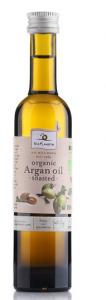
Argan Oil
€ Core price
The Argan tree, with its large shade giving leaves, is one of the oldest species of tree on earth. Slowly disappearing completely, it is now only found in south-west Morocco. Several projects have been launched to save the tree which is now protected by UNESCO.
Argan trees can fruit several times a year. The flesh of the fruit is similar to that of olives but is inedible for humans, and it is the stones which are used for producing oil.
Berber women crack the nuts by hand between two stones to extract the two or three oil-containing kernels, and then, according to Berber practice, they are lightly roasted before being pressed. About 35 kg of fruit yields one litre of oil.
Our organic argan oil comes from an oil mill in Morocco where argan oil production assures the local population of revenue and the reforestation and maintenance of this endangered species also prevents the encroachment of the desert.
Argan trees can fruit several times a year. The flesh of the fruit is similar to that of olives but is inedible for humans, and it is the stones which are used for producing oil.
Berber women crack the nuts by hand between two stones to extract the two or three oil-containing kernels, and then, according to Berber practice, they are lightly roasted before being pressed. About 35 kg of fruit yields one litre of oil.
Our organic argan oil comes from an oil mill in Morocco where argan oil production assures the local population of revenue and the reforestation and maintenance of this endangered species also prevents the encroachment of the desert.
Supplier


Company

Website
 France
France
Country
Product details
Place of processing
-
Origin of main ingredient

Origin of main ingredient

Packaging formats

Packaging

Composition


